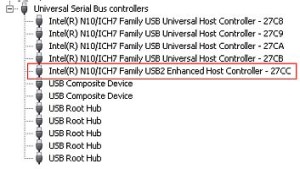1.) Go to Control panel – Device Manager.
2.) Expand “Universal Serial Bus controllers”, you should see a word “Enhanced” or “Hi-speed” in there. If not, your entire USB ports are still using the old version 1.1. If you see the word enhanced, then it is using USB 2.0.
If you now have USB 2.0, there are USB audio interfaces that can accept up to 8 simultaneous recordings provided they are connected via USB 2.0. But you have fewer choices out there for a USB 2.0 audio interface with a lot of inputs compared to a Firewire audio interface with the same amount of inputs.
Even if you are using USB 2.0, there is still a catch. At the similar speed with USB 2.0, Firewire considerably uses a lower CPU and memory usage on your PC. With this, it is even more advantageous to have an ASIO Firewire audio interface because an ASIO driver does not put strenuous task on your PC CPU and memory resources.
This implies that for a lot of inputs (such as an ambitious multi-track recording project), a Firewire audio interface is an advantage because of lower system resources usage and offering a fast data transfer rates.
Criteria #3: Price and Flexibility
Firewire audio interface is slightly expensive compared to their USB audio interface counterparts. Probably because most high-end audio interface manufacturers are using Firewire connections with numerous inputs. USB audio interface is always available in the low budget range typically for those that are looking and recording two channels at a time.
Regarding flexibility, there will be more issues with USB audio interface. Since most external devices that are to be connected to your PC are using USB nowadays, chances are when you are connecting another USB device (for example a 1 TB external hard drive) it will consume and steal a lot of bandwidths from your USB audio interface.
Although this problem can solve by using a dedicated USB controller to audio interface, it can be tricky to do because your PC might be operating around a single USB controller.
This problem can be avoided with Firewire audio interface. It is because if you plug a Firewire audio interface, then the entire Firewire bandwidth will be dedicated to playback and recording without any conflicts. Even if you plug a high bandwidth USB device, it won’t affect with the Firewire audio interface bandwidth because they are on different connections.
Since most PC has USB slots on them, if you want a dedicated audio processing (for recording and playback); then you should be utilizing your Firewire ports for connecting the audio interface while you will be using the USB slots for other devices (printers, mouse, external hard drive, cameras, etc.). This can avoid the bandwidth limitation issues with USB that can affect latency, recording quality and playback.
The bottom line in the selection process between USB and Firewire audio interface is to determine which one works for your needs. In every decision made based on the above factors, there is always some trade-off. For example, you sacrifice high cost by investing a multi-channel Firewire audio interface and spending a higher budget on your PC so that you can take advantage of what Firewire can offer. Or if you do not want to upgrade your PC or buy any new hardware because of budget constraints and would just stick to USB audio interface despite some issues with USB 1.1, bandwidth constraints or CPU/memory usage. It is all about knowing these pros and cons so that you can determine which one really works for you.
Content last updated on August 5, 2012
